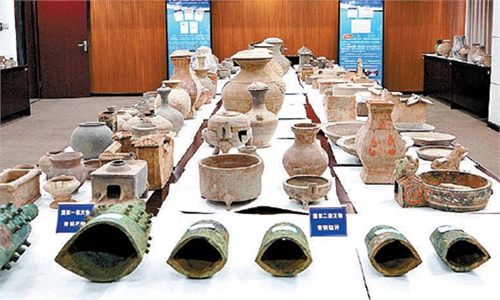ARTS / ART
Xiong'an prioritizes protection of intangible cultural heritage

Illustration: Hang Dachuan/Global Times
The Xiong'an New Area in North China's Hebei Province has made a name for itself with new urban development, but its cultural heritage has also been a highlight as well.
During the Lantern Festival on Sunday, a series of activities were held to showcase the new area's intangible cultural heritage, including drum performances, Dragon Lantern exhibits and stilt parades.
Actually, these only account for a small portion of the intangible cultural heritage of Xiong'an. The area boasts more than 200 items of intangible cultural heritage at the provincial, city and county levels, including martial arts, folk literature and music, and handicrafts. Among them, eagle claw boxing, a second-class national-level intangible cultural heritage, is well known. Besides this, traditional Xiong'an music concerts are another popular art form. They consist of both wind and percussion instruments such as the reed pipe wind instrument, gong, cymbals and drums. Originating from the Song Dynasty (960-1279), they were often performed at ceremonies, rituals and funerals.
Established in April 2017, the Xiong'an New Area is considered one of China's "millennium" projects. The region's development plan was a hot topic back then. This was because in the beginning of China's reform and opening-up, the rapid speed of China's urbanization sparked mass construction across the countryside, which in some cases led to poor protection of cultural relics. So when the Xiong'an New Area was first planned, protection of cultural heritage was a top priority, as Chinese President Xi Jinping strongly emphasized the protection and promotion of fine traditional Chinese culture and history.
Composed of the Xiongxian, Rongchen and Anxin counties and their neighboring areas, Xiong'an is an area with a long history and rich cultural heritage. Apart from intangible cultural heritage, there are more than 100 historical sites as well as cultural relics ranging from the Neolithic period to the War of Resistance against Japanese Aggression (1931-45).
In order to carry out Xi's strategy, an all-out plan for cultural relic protection and archaeology to coexist with economic development was carried out in Xiong'an. This stipulates that construction sites have to be approved by the State Administration of Cultural Relics and that areas containing immovable relics should be avoided as much as possible. During this process, Xiong'an gained nationwide support. The State Administration of Cultural Relics, the Institute of Archaeology of the Chinese Academy of Social Sciences, the Chinese Academy of Cultural Heritage, the Hebei Provincial Department of Culture, the Hebei Bureau of Cultural Relics have all sent experts to take part in its efforts toward archaeology and historical relics protection.
Over the past few years, the region has achieved "win-win" results in its new area development and the inheritance of history and cultural heritage, providing material proof of Xiong'an's millenniums of historical and cultural progress. It shows that while launching a large-scale construction of the area, a "cultural tower" is also being built.
Culture is a valuable resource, so Xiong'an has chosen the right path by achieving balance between economic development and cultural heritage protection.

